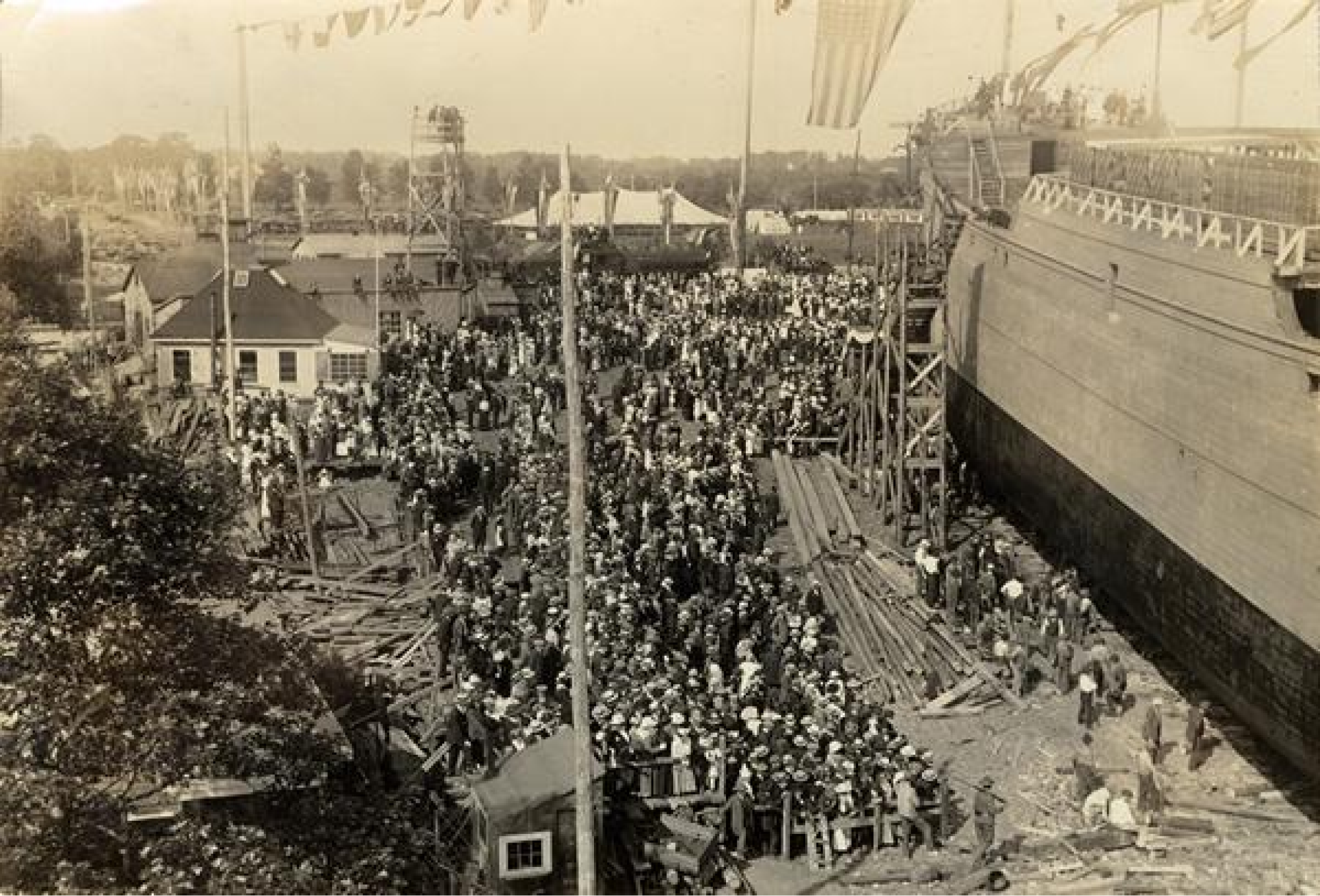When America declared war on Germany in April of 1917, there was already a shortage of cargo ships. To address the need, the government created the U.S. Emergency Fleet Corp. Swiftly, contract orders went out across the country to build a new merchant fleet to transport supplies, food and ammunition to the U.S. troops.
In August of 1917, L. H. Shattuck Inc. received a contract to build 15 Ferris-style wooden steamship hulls. The engines would be installed later in Portland, Maine. The firm acquired riverfront property in Newington from the heirs of Valentine Coleman, approximately 35 acres, and it quickly began construction of the Shattuck shipyard. The first keels were laid down in November of that year.
Area businesses like the Dover brickyards had to close because all the laborers went to work at Shattuck. For most, there was a sense of urgency and patriotic duty. The shipyard workers came from all types of professions including ministers, school teachers, lawyers, machinists, students of medicine, and even a vaudeville actor. Most employees were men, but there were also a few women.
The area surrounding the shipyard became a boomtown. There was an office building, a hotel, a hospital, a restaurant, a store called “Mary’s Place,” and countless tents and shacks in the fields around the shipyard to accommodate the influx of workers. For those who lived in nearby communities, they could commute on the Dover and Portsmouth railway.
Remarkably, in two years, Shattuck constructed the contracted wooden steamships, each weighing 3,500 tons (1,500 tons larger than any clipper ship that had been constructed in the previous century). In order to do this, Shattuck built six ways, each occupied with the construction of a ship. One hull took about six months to complete. At the peak of operation, Shattuck employed over 8,000 people a day with 5,500 working the day shift and 2,800 working the night shift.
On Sept. 1, 1918, the Director General of the Emergency Fleet Charles M. Schwab inspected the Shipyard. After his tour, he said, “The Shattuck yard is the largest and best equipped wooden shipyard that I have inspected in the country. I am delighted with everything -- the size of the yard is sufficient to build anything.”
The president of L. H. Shattuck Inc. was Louis Herbert Shattuck (1874-1919) who was born in Andover, Massachusetts. In Massachusetts, Shattuck practiced law before he entered in the building and contractor business and owned his own firm in Boston. Later he bought a building firm in Manchester, which led him to Newington during World War I. Shattuck was a gifted problem solver, and by all accounts a fair and thoughtful leader.
On July 4, 1918, the Chibiabos became the first ship launched at Shattuck and the first of three ships launched on that day alone. An estimated crowd of 10,000 came to the patriotic launching. The ambitious triple launch was part of the Tidal Wave, a national event sponsored by the Emergency Fleet Corp. Where 95 ships across the country were all launched on the Fourth. The Chibiabos was named by First Lady Edith Wilson (who was originally supposed to sponsor the ship, but later sent her regrets) from the “Song of Hiawatha” by Henry Wadsworth Longfellow.
In 1970, author and photographer John P. Adams interviewed a former Shattuck employee, Elmer I. Brooks (1899-1971) of Newington. As a young man, Brooks worked as a ship fastener at the shipyard. The transcript was published first in Adams’ article “Six Ways to Build Wooden Ships” in Yankee Magazine (Nov. 1970) and later in Adams’ book “Drowned Valley: The Piscataqua River Basin.” Adams was clever to transcribe the dialogue of Elmer phonetically because in reading Elmer’s words, you hear his voice and perhaps a sense of the shipyard. You also understand the imminent danger the shipyard workers were in at all times.
“The workers come from all over the globe, see. Woodchoppers, farm boys, and everyone from way back Down Maine, way up New Hampshire, where they never see a mailman. Woodchoppers and butchers and barbers,” Brooks recalled. “Yeh, and old guys. They had some old guys up there. Some with one eye. Everybody worked there. It was an awful crew, just like over in the Navy Yard ...”
“I worked nights, I worked days, sometimes nights, sometimes days, but it’d be one continuous shift, right around. Night and day. Walkin’ around on those stagin’s, had everything there, and everybody working there. Some of them didn’t know nothin’. They had ten or fifteen men on a stagin’ up above the next stagin’ puttin’ plankin’ on. Somebody’d drop a broad axe down with ten or fifteen men right under them. Water boy runnin’ around with a bucket of water got a chisel right down through his skull. Lug ’em out and ever see ’em again.”
After the war ended on Nov. 11, 1918, people wondered if the shipyard would close; however, the Emergency Fleet Corp. stressed a need to rebuild the merchant fleet even in peace time, but the feverish pitch before the war gradually slowed. Over the winter of 1919, Louis H. Shattuck fell sick, and after a nine-month battle with lung cancer, he died July 28, 1919, in Manchester. At the time of his death, the Boston Globe referred to him as “one of the foremost businessmen in New Hampshire.” Shortly afterward, the Shattuck shipyard launched its last hull, the Newburyport, though it appears the hull never left the yard.
And just like that, the once frenetic and productive assembly line of wooden steamships stopped, and the Shattuck shipyard slipped of its ways and into the murky maritime history of the Piscataqua River. The Atlantic Chemical Dye Stuff Corp., of Boston, purchased the former site of the Shattuck shipyard in November of 1919. The Atlantic Terminal Corp. acquired the property to use as an oil depot by 1931, but much of the former shipyard remained untouched.
Article Written by James Smith / Portsmouth Athenaeum and published in Seacoast Online.
https://www.seacoastonline.com/news/20191013/at-athenaeum-look-back-at-shattuck-shipyard


